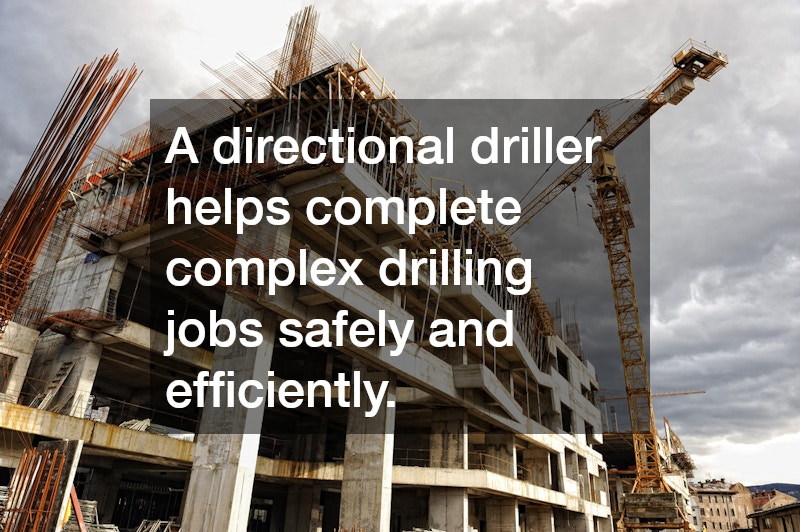A directional driller plays a critical role on job sites where underground work needs to be accurate, efficient and minimally invasive. These skilled professionals guide specialised drilling equipment to create boreholes that follow a planned path underground—often navigating around existing infrastructure, natural obstacles or surface restrictions.
Directional drillers are often found working on civil projects, utility installations, oil and gas fields or large-scale infrastructure upgrades. Their job is not only technical but also strategic, requiring precise control and ongoing communication with engineers and site supervisors.
Let’s examine what a directional driller does on site and why their expertise is so important.
Planning and setup
Before any drilling begins, a directional driller is involved in reviewing plans and mapping out the drill path. This includes examining ground conditions, identifying obstacles like pipes or tree roots and calculating entry and exit points.
Once the plan is in place, the driller helps set up the drilling rig and related support equipment. This can include locating drilling fluid systems, preparing tracking gear and confirming that safety protocols are followed. The initial phase is crucial because any mistake in setup can lead to misalignment or costly delays.
At this stage, the directional driller works closely with engineers and surveyors, using maps, GPS data and ground-penetrating technology to verify that everything is ready.
Guiding the drill
The core responsibility of a directional driller is to guide the drill head through the ground along the planned route. Unlike traditional vertical drilling, directional drilling requires constant adjustments to the angle, depth and direction of the borehole.
This is done using a combination of onboard sensors, tracking tools and real-time feedback systems. The driller monitors data on a screen and makes calculated decisions to steer the drill head accurately. They may also rely on electromagnetic signals or wireline systems to track the drill’s position underground.
This stage demands high concentration and technical knowledge. A directional driller must adjust for unexpected ground conditions, like hitting rock or water pockets, while keeping the drill on course. Precision is essential, especially when drilling near underground utilities or in environmentally sensitive areas.
Managing drilling fluids
Special fluids are pumped into the borehole to support the drilling process. These fluids help reduce friction, remove cuttings and stabilise the hole. A directional driller oversees the use and flow of these fluids to ensure safe and smooth drilling.
The choice of fluid depends on the ground type and project requirements. The driller may need to change flow rates or composition mid-job to adapt to changing conditions. Improper fluid management can cause the hole to collapse or damage the drill equipment.
Managing these systems is another technical aspect of the job, requiring knowledge of fluid dynamics, pressure levels and environmental regulations.
Handling troubleshooting and delays
Not every drilling project goes according to plan. A directional driller is responsible for identifying issues and reacting quickly when problems arise. These might include a jammed drill head, unexpected underground barriers or equipment failure.
In such cases, the driller works with the crew to stop operations, inspect the issue, and devise a solution. Sometimes, the drill path must be altered or remapped. Other times, a new strategy is required to bypass the problem and continue without damaging the surrounding area.
Good problem-solving skills are essential. One key trait of an experienced directional driller is the ability to stay calm and make informed decisions under pressure.
Logging and reporting
Once drilling is complete, a directional driller prepares logs and reports that detail how the job was carried out. This includes information about the path taken, equipment used, adjustments made and any issues encountered.
These reports are shared with engineers, project managers and sometimes local authorities. They provide a record for future maintenance or inspections and help evaluate the project’s success.
Accurate documentation is part of maintaining safety standards and ensuring that underground assets are properly installed and recorded.
Collaborating with the site team
Although directional drilling is a specialised role, the driller is part of a larger team. They communicate with rig operators, surveyors, safety officers and project managers throughout the day.
Coordination is key, especially on busy job sites where other trades are working nearby. The directional driller needs to understand the timing of different tasks and adjust their work to avoid delays or conflicts.
This collaboration helps projects run on schedule and ensures that everyone on site is informed of progress, potential risks and changes in conditions.
A directional driller brings precision and expertise to underground projects where accuracy matters. From setting up the drill to guiding it through challenging ground conditions and managing fluids, the role demands a mix of technical skill, real-time decision making and teamwork.
By using the latest tools and technology, a directional driller helps complete complex drilling jobs safely and efficiently, often without disturbing the surface above. Their work is essential to the success of many infrastructure and utility projects, whether for installing pipes, cables or conduit.



